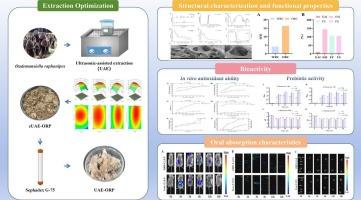Structural characterization, functional properties, bioactivity and oral absorption characterstics of Oudemansiella raphanipies polysaccharides
IF 8.2
1区 农林科学
Q1 CHEMISTRY, APPLIED
引用次数: 0
Abstract
The medicinal fungus Oudemansiella raphanipies (O. raphanipies) attracts significant interest for its broad-spectrum bioactivities, with its polysaccharide demonstrating particularly notable pharmacological properties. This study systematically investigated the extraction, physicochemical properties, structural, functional traits, biological activities, and oral absorption of O. raphanipies polysaccharide. Response surface methodology optimized the extraction condition of O. raphanipie polysaccharides by UAE method, achieving a yield of 210.35 ± 0.20 mg/g (55 °C, 90 min, 250 W, 1: 60 g/mL). The purified O. raphanipie polysaccharide (UAE-ORP) (568.57 kDa), an α-pyranose mainly composed of glucose (35.48%) and galactose (28.51%), showed high thermal stability (322 °C). In addition, UAE-ORP showed interesting water retention capacity and oil retention capacity, and good foaming and emulsion properties. UAE-ORP demonstrated potent antioxidant activity, with DPPH scavenging rate reaching 90.43% and hydroxyl radical scavenging rate at 57.13%, significant inhibition of BSA denaturation (97.49%) and NO secretion, and potential prebiotic effects. UAE-ORP was significantly distributed in the gastrointestinal tract based on NIR imaging result, retaining in intestines for 24 h, indicating its potential as a prebiotic agent. Thus, UAE-ORP is a promising functional food additive with integrated advantages.

raphanipies Oudemansiella多糖的结构表征、功能特性、生物活性和口服吸收特性
药用真菌Oudemansiella raphanipies (O. raphanipies)因其广谱生物活性引起了人们的极大兴趣,其多糖表现出特别显著的药理特性。本研究系统地研究了蛇麻多糖的提取、理化性质、结构、功能特征、生物活性和口服吸收。响应面法优化了UAE法提取大黄果多糖的条件,得率为210.35±0.20 mg/g(55℃,90 min, 250 W, 1:6 0 g/mL)。纯化的O. raphanipie多糖(UAE-ORP) (568.57 kDa)是一种主要由葡萄糖(35.48%)和半乳糖(28.51%)组成的α-吡喃糖,具有较高的热稳定性(322℃)。此外,UAE-ORP具有良好的保水和保油性能,并具有良好的起泡和乳化性能。UAE-ORP具有较强的抗氧化活性,对DPPH的清除率达90.43%,对羟基自由基的清除率达57.13%,对牛血清白蛋白变性(97.49%)和NO分泌有明显的抑制作用,并具有潜在的益生元效应。近红外成像结果显示,UAE-ORP在胃肠道中有明显分布,并在肠道内停留24 h,提示其作为益生元制剂的潜力。因此,UAE-ORP是一种具有综合优势的功能性食品添加剂。
本文章由计算机程序翻译,如有差异,请以英文原文为准。
求助全文
约1分钟内获得全文
求助全文
来源期刊

Food Chemistry: X
CHEMISTRY, APPLIED-
CiteScore
4.90
自引率
6.60%
发文量
315
审稿时长
55 days
期刊介绍:
Food Chemistry: X, one of three Open Access companion journals to Food Chemistry, follows the same aims, scope, and peer-review process. It focuses on papers advancing food and biochemistry or analytical methods, prioritizing research novelty. Manuscript evaluation considers novelty, scientific rigor, field advancement, and reader interest. Excluded are studies on food molecular sciences or disease cure/prevention. Topics include food component chemistry, bioactives, processing effects, additives, contaminants, and analytical methods. The journal welcome Analytical Papers addressing food microbiology, sensory aspects, and more, emphasizing new methods with robust validation and applicability to diverse foods or regions.
 求助内容:
求助内容: 应助结果提醒方式:
应助结果提醒方式:


